Seborrheic Dermatitis Symptoms, Causes, And Treatments

Seborrheic Dermatitis (SD) is common skin condition known for its chronic and recurrent nature. Although not life-threatening, SD can cause considerable discomfort (resulting in persistent redness, scaling, and itching) and impact the quality of life.
Understanding seborrheic dermatitis is the first step towards managing it effectively. By recognizing the symptoms and causes, you can take steps to prevent flare-ups and find the right treatment for you.
In this blog post, we delve into the causes, symptoms, risk factors, diagnosis, and treatment options for this skin condition.
What Is Seborrheic Dermatitis?
Seborrheic Dermatitis is a common skin condition characterized by the appearance of scaly patches, inflamed skin, and stubborn dandruff. While it primarily affects the scalp, SD may also appear on oily areas of the body such as the face, sides of the nose, eyebrows, ears, eyelids, and chest.
While the precise cause remains unclear, factors like the proliferation of the yeast Malassezia, excessive oil in the skin, or an issue in the immune system are known to contribute. It is important to note that SD is not contagious and does not result in permanent hair loss.
Who’s At Risk For Developing Seborrheic Dermatitis?
SD can affect individuals of all ages and races. However, it commonly manifests during life stages:
- Infancy (2 to 12 months)
- Adolescence
- Adulthood (typically beginning in the individual’s 30s or later)
In infants, SD usually appears on the scalp, known as ‘cradle cap,’ but may also develop in skin folds, chest, back, or diaper area. In adults, the condition is often chronic, with flare-ups occurring intermittently.
SD is particularly common in adults over 50. Several studies indicate that many adults aged 65 and above live with this condition. It is more common in males than in females.
Causes of Seborrheic Dermatitis
While the exact cause of seborrheic dermatitis is not known, several factors are thought to contribute to its development. A key factor is the yeast Malassezia, which is a normal component of skin flora. The lipases and phospholipases produced by this yeast cleave free fatty acids from triglycerides present in sebum, potentially inducing inflammation.
Other contributing factors include hormone levels, certain genetic factors, stress, changes in weather or overall health, nutritional deficits, and neurological factors. Differences in skin barrier lipid content and function could account for individual presentations.
It is important to remember that while these factors can increase the risk of developing seborrheic dermatitis, they do not cause it directly. Instead, they seem to trigger an abnormal response in the skin, leading to inflammation and symptoms of seborrheic dermatitis
Common Symptoms of Seborrheic Dermatitis
Symptoms in Infants
In infants, SD, often referred to as cradle cap, results in a greasy scaling on the scalp. The rash may spread to the armpit and groin folds. This rash tends to appear pink, with possible flaking or peeling.
Symptoms in Adults
In adults, SD generally presents as:
- Dandruff on the scalp, hair, eyebrows, beard, or mustache
- Patches of greasy skin covered with flaky white or yellow scales or crust on the scalp, face, sides of the nose, eyebrows, ears, eyelids, chest, armpits, groin area, or under the breasts
- Rash that may look darker or lighter in people with brown or Black skin and redder in those with white skin
- Itchiness (pruritus)
If you have seborrheic dermatitis on your scalp, you may notice dandruff or thick, crusty patches. These patches can be yellow or white and may feel oily or moist. On the face and chest, seborrheic dermatitis can cause redness and scaling, which can sometimes be mistaken for other skin conditions like eczema or psoriasis.
Complications of Seborrheic Dermatitis
While SD is not usually a severe condition, it can have a significant psychosocial impact due to the appearance of the skin.
How Is Seborrheic Dermatitis Diagnosed?
SD is typically diagnosed through a visual inspection of the skin, based several factors such as the location, appearance, and behavior of the lesions. If the diagnosis is uncertain, a skin biopsy can be performed. However, the presence of Malassezia yeast on skin scrapings is not diagnostic, as it is a standard component of skin flora.
For treatment to be effective, SD needs to be differentiated from several other skin conditions that have similar characteristics, including:
- Eczema
- Candidiasis
- Contact Dermatitis
- Erythrasma
- Impetigo
- Psoriasis
- Rosacea
Can Seborrheic Dermatitis Be Prevented?
While there is no way to prevent SD, there are ways to manage the condition by reducing the frequency and severity of flare-ups. Some of the most effective preventive measures include keeping the skin clean and moisturized, avoiding harsh soaps and shampoos, and managing stress.
Regular cleansing can help reduce the amount of oil and yeast on the skin, potentially reducing symptoms. Moisturizing can help prevent dryness and scaling. It is also important to choose products that are designed for sensitive skin to avoid irritating the skin further.
Stress management is another key element of seborrheic dermatitis prevention. Stress can trigger flare-ups, so finding ways to manage stress, like regular exercise and relaxation techniques, can be beneficial.
Seborrheic Dermatitis Treatment Options
There are many effective treatments for seborrheic dermatitis, ranging from over-the-counter products to prescription medications. These treatments target the symptoms of seborrheic dermatitis, reducing redness, itching, and scaling.
Over-the-counter treatments often include medicated shampoos and creams that contain ingredients like ketoconazole, selenium sulfide, or zinc pyrithione. These ingredients can help reduce the yeast on the skin and alleviate symptoms.
For more severe cases, your doctor may prescribe a topical steroid or antifungal medication. These treatments can be highly effective, but they should be used under a doctor’s supervision to avoid potential side effects.
In recent years, there have been exciting advancements in the treatment of seborrheic dermatitis. One such advancement is the development of biologic drugs, which target specific parts of the immune system to reduce inflammation. While these treatments are still in the early stages of development, they hold promise for the future treatment of seborrheic dermatitis
Disclaimer: The contents of the Westlake Dermatology website, including text, graphics, and images, are for informational purposes only and are not intended to substitute for direct medical advice from your physician or other qualified professional.
